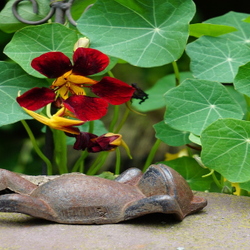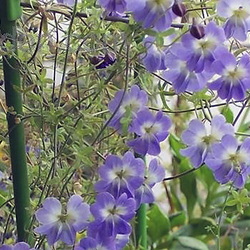 Among all the plants I saw at my grandmother's house during my childhood, Nasturtium was the one which I loved the most. I remember seeing it hanging in large old cooking pots out in the garden, with numerous orange flowers. My grandmother told me its name was "călţunaş"(pronounced "kaltzunash"), meaning wool socket in an old Romanian dialect or "conduraş" meaning a small old-fashioned Turkish slipper (from the Turkish word "kundura"- shoe). The name must be related to the resemblance of the nasturtium flower's curled spur to an old fashioned Turkish slipper or a wool socket. It's been years since I saw one in people's pots or gardens, but it seems to be coming back into fashion lately.
Among all the plants I saw at my grandmother's house during my childhood, Nasturtium was the one which I loved the most. I remember seeing it hanging in large old cooking pots out in the garden, with numerous orange flowers. My grandmother told me its name was "călţunaş"(pronounced "kaltzunash"), meaning wool socket in an old Romanian dialect or "conduraş" meaning a small old-fashioned Turkish slipper (from the Turkish word "kundura"- shoe). The name must be related to the resemblance of the nasturtium flower's curled spur to an old fashioned Turkish slipper or a wool socket. It's been years since I saw one in people's pots or gardens, but it seems to be coming back into fashion lately. Tropaeolum majus, also called garden nasturtium, Indian cress or monk's cress, is a flowering plant in the Tropaeolaceae family, native to Andes  mountains, from Bolivia to Colombia. It isn't related to the genus Nasturtium, which includes watercress, but it has been called nasturtium (which is Latin for "nose-twister") because of its peppery taste, similar to the plants included in this genus. The first nasturtiums, brought during the 16th century to Europe by the Spanish conquistadors, were a dwarf variety, Tropaeolum minor, which produced small yellow flowers. Many hybrids were created afterwards and the most worldwide appreciated was Tropaeolum majus.[1]
mountains, from Bolivia to Colombia. It isn't related to the genus Nasturtium, which includes watercress, but it has been called nasturtium (which is Latin for "nose-twister") because of its peppery taste, similar to the plants included in this genus. The first nasturtiums, brought during the 16th century to Europe by the Spanish conquistadors, were a dwarf variety, Tropaeolum minor, which produced small yellow flowers. Many hybrids were created afterwards and the most worldwide appreciated was Tropaeolum majus.[1]
Nasturtium is an annual herbaceous plant, with trailing stems which can grow up to 3 feet (1 meter) or more. The leaves are peltate (with the stem underneath the round leaf) and large 1 to 6 inch (3 to 15cm), with several veins, all radiating from the petiole to the margins. Leaves' color is green, but some species have variegated leaves. Flowers are about 1 to 2 inches (2.5 to 6cm) with five petals, eight stamens and a nectar spur at the rear, about 1 inch (3cm) long. Their color ranges from yellow to orange and red. The fruit is less than an inch, with three segments, each segment containing a single large seed, of about 0.6 inch (1.5cm).[1]


A very interesting phenomenon happens when watching a nasturtium flower bed, with orange flowers, in the twilight. When Elizabeth von Linne (daughter of the famous scientist Carl Linnaeus) first discovered it, scientists thought it was an electrical or phosphorescence phenomenon. But later it has been proved to be just an optical illusion, caused by the way our human eyes perceive the orange color of the nasturtium flowers upon the green leaves, at dusk. This phenomenon has been known as the "Flashing flowers" or the "Elisabeth Linnaeus Phenomenon".[2]



 Nasturtium's leaves and flowers are edible, having a slightly peppery and sour taste. The flower contains 130mg vitamin C per 100g flowers, almost as much as parsley. They also contain lutein, in the highest amount of any other edible plant. Lutein is an organic yellow pigment, scientifically known as xanthophyll. It is included in the carotenoids, together with the carotenes. Lutein is responsible for the photoprotection of the eye's macula against the free radicals of the blue light.[3] Nasturtium's unriped fruits can be harvested and pickled in vinegar, then used in salads, same as capers.[1]
Nasturtium's leaves and flowers are edible, having a slightly peppery and sour taste. The flower contains 130mg vitamin C per 100g flowers, almost as much as parsley. They also contain lutein, in the highest amount of any other edible plant. Lutein is an organic yellow pigment, scientifically known as xanthophyll. It is included in the carotenoids, together with the carotenes. Lutein is responsible for the photoprotection of the eye's macula against the free radicals of the blue light.[3] Nasturtium's unriped fruits can be harvested and pickled in vinegar, then used in salads, same as capers.[1]
I had a very large nasturtium bed the first year I sowed it. I had seeds from several varieties, from yellow, to red and orange and with variegated leaves. After installing a new sewage tank - which happened to be right beneath the strawberries patch - I found myself without strawberries, but also with a large bare flower bed which needed to be filled with lots of flowers. It was perfect for nasturtiums and also for petunias and French marigolds; they all need space. I sowed many seeds and waited. The other plants grew very well, but the nasturtiums didn't at first, because of some worms they had inside their leaves. I found out those were leaf miners - maggots of different insect species which grow inside the leaf, making tunnels inside it, while feeding with the leaf's cells.


I also found a few dozens of minuscule eggs on one leaf; after a week there was a big hole in it and I could see some minuscule catterpillars. They were from the Cabbage butterfly, Pieris brassicae, a very common pest.



 After spraying them regularly with an insecticide, the pests dissapeared and the nasturtiums started to grow bigger and bigger. I had to water on a daily regular basis, but the result was stunning. I had a huge mass of nasturtium leaves, with lots of beautiful colored flowers. Luckily, I found out just in time, before the first frost, that nasturtium's leaves and flowers are edible. I picked up as many leaves as I could and stored them in plastic bags in the fridge, then ate them fresh in salads, with their flowers on top. I really enjoyed their taste and appearance, which made me repeat nasturtium's cultivation every year, ever since. You can try it too, you might be pleasantly surprised of the result!
After spraying them regularly with an insecticide, the pests dissapeared and the nasturtiums started to grow bigger and bigger. I had to water on a daily regular basis, but the result was stunning. I had a huge mass of nasturtium leaves, with lots of beautiful colored flowers. Luckily, I found out just in time, before the first frost, that nasturtium's leaves and flowers are edible. I picked up as many leaves as I could and stored them in plastic bags in the fridge, then ate them fresh in salads, with their flowers on top. I really enjoyed their taste and appearance, which made me repeat nasturtium's cultivation every year, ever since. You can try it too, you might be pleasantly surprised of the result!


[1] - http://en.wikipedia.org/wiki/Tropaeolum_majus
[2] - http://blogs.nybg.org/science-talk/2013/12/flashes-in-the-twilight/
[3] - http://en.wikipedia.org/wiki/Lutein
















